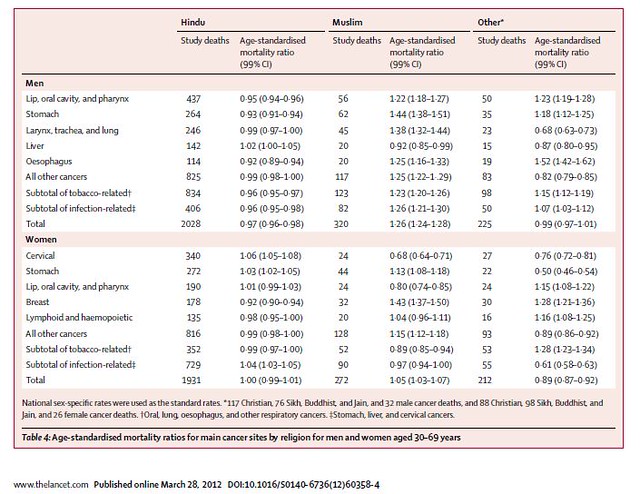By TCN News,
New Delhi: A comprehensive survey of cancer deaths in India published in the respected medical journal Lancet has concluded that 71% of cancer deaths occurred in people in the 30-69 years age group. In this age group, the three most common fatal cancers, according to the survey, were oral (23%), stomach (13%), and lung (11%) in men, and cervical (17%), stomach (14%), and breast (10%) in women.
“Most cancer deaths occurred in Hindus in roughly similar proportion to the national Hindu population. Muslim men had higher age-standardised mortality ratios for most cancers than did Hindus and other religious groups, but a slightly lower ratio for liver cancer than did Hindus (table 4). Muslim women had notably low age-standardised mortality ratios for cervical and oral cancers, but higher ratios for breast and stomach cancers,” study concluded after analyzing the data across religious groups.

The Muslim factor for cervical cancer was so pronounced that that the rate for this type of cancer in Jammu & Kashmir and Assam was less than a quarter of the national rates, states where Muslims are significant part of the state population.
“Cervical cancer is the leading cause of cancer death in women in both rural and urban areas. “ The risk of dying from cervical cancer for a woman is higher than risk of dying during pregnancy.
Authors suggested circumcision among Muslim men is the most likely cause of lower rate of cervical cancer among Muslim women. Circumcision reduced the sexual transmission of human papilloma virus, most common cause of the cervical cancer.
This study is significant and more accurate that National Cancer Registry Programme as the registry obtains data mostly from urban centers and leaves out rural India.
The study found that rates of cancer deaths were generally similar between rural and urban areas and about twice as high in the least versus the most educated.
This study was funded by Bill & Melinda Gates Foundation and US National Institutes of Health.
From the abstract
Methods: At least 130 trained physicians independently assigned causes to 122 429 deaths, which occurred in 1·1 million homes in 6671 small areas that were randomly selected to be representative of all of India, based on a structured nonmedical surveyor’s fi eld report.
Findings: 7137 of 122 429 study deaths were due to cancer, corresponding to 556 400 national cancer deaths in India in 2010. 395 400 (71%) cancer deaths occurred in people aged 30–69 years (200 100 men and 195 300 women). At 30–69 years, the three most common fatal cancers were oral (including lip and pharynx, 45 800 [22·9%]), stomach (25 200 [12·6%]), and lung (including trachea and larynx, 22 900 [11·4%]) in men, and cervical (33 400 [17·1%]), stomach (27 500 [14·1%]), and breast (19 900 [10·2%]) in women. Tobacco-related cancers represented 42·0% (84 000) of male and 18·3% (35 700) of female cancer deaths and there were twice as many deaths from oral cancers as lung cancers. Age-standardised cancer mortality rates per 100 000 were similar in rural (men 95·6 [99% CI 89·6–101·7] and women 96·6 [90·7–102·6]) and urban areas (men 102·4 [92·7–112·1] and women 91·2 [81·9–100·5]), but varied greatly between the states, and were two times higher in the least educated than in the most educated adults (men, illiterate 106·6 [97·4–115·7] vs most educated 45·7 [37·8–53·6]; women, illiterate 106·7 [99·9–113·6] vs most educated 43·4 [30·7–56·1]). Cervical cancer was far less common in Muslim than in Hindu women (study deaths 24, age-standardised mortality ratio 0·68 [0·64–0·71] vs 340, 1·06 [1·05–1·08]).
